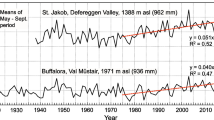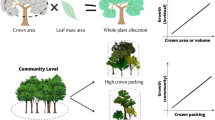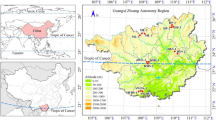Abstract
Key message
Changes in tree’s climate sensitivity during their ontogenetic development is best assessed with stem diameter classes, which can be calculated retrospectively from the cumulative ring width.
Abstract
Climate affects tree growth but the effect size can be modulated by other variables, including tree’s age and size. To assess how climate sensitivity changes over the life of a tree, previous studies mostly stratified trees into age classes, while cambial ring-age stratification (age-band decomposition) was less frequently used. However, trees do not age as other organisms and arguably age is mainly a proxy for size, which in contrast to age has been shown to affect wood anatomy and physiology. Stem diameter classes, calculated from cumulative ring width, could thus facilitate a more direct assessment of size effects. Here we compare these three methods, which differ regarding how they stratify data into age/size classes. We found that using age-band decomposition and cumulative ring-width classes had major advantages over the tree-age method: (a) age and size are decoupled from other temporal changes, like atmospheric CO2 concentration or nitrogen deposition, which excludes potential biases. (b) Shifts in climate sensitivity occur earlier than estimated by the tree-age method. (c) Younger/smaller classes can be assessed. Furthermore, direct comparison supports that size, rather than age, alters climate sensitivity. Therefore, the cumulative ring-width method appears to be the best approach to assess the effect of ontogenetic changes on a tree’s climate sensitivity. Understanding how climate sensitivity changes when trees get older and larger is important for forest ecology and management, climate reconstructions, global carbon models and can help to study age and height limitations of trees.




Similar content being viewed by others
References
Allen CD, Macalady AK, Chenchouni H et al (2010) A global overview of drought and heat-induced tree mortality reveals emerging climate change risks for forests. For Ecol Manag 259:660–684. https://doi.org/10.1016/j.foreco.2009.09.001
Babst F, Alexander MR, Szejner P et al (2014) A tree-ring perspective on the terrestrial carbon cycle. Oecologia 176:307–322. https://doi.org/10.1007/s00442-014-3031-6
Bates D, Mächler M, Bolker B, Walker S (2015) Fitting linear mixed-effects models using lme4. J Stat Softw. https://doi.org/10.18637/jss.v067.i01
Beguería S, Vicente-Serrano SM (2013) SPEI: calculation of the standardised precipitation-evapotranspiration index. R Package Version 1
Bond BJ (2000) Age-related changes in photosynthesis of woody plants. Trends Plant Sci 5:349–353. https://doi.org/10.1016/S1360-1385(00)01691-5
Bond BJ, Czarnomski NM, Cooper C et al (2007) Developmental decline in height growth in Douglas-fir. Tree Physiol 27:441–453. https://doi.org/10.1093/treephys/27.3.441
Bontemps J-D, Esper J (2011) Statistical modelling and RCS detrending methods provide similar estimates of long-term trend in radial growth of common beech in north-eastern France. Dendrochronologia 29:99–107. https://doi.org/10.1016/j.dendro.2010.09.002
Bottero A, D’Amato AW, Palik BJ et al (2017) Density-dependent vulnerability of forest ecosystems to drought. J Appl Ecol. https://doi.org/10.1111/1365-2664.12847
Bowman DMJS, Brienen RJW, Gloor E et al (2013) Detecting trends in tree growth: not so simple. Trends Plant Sci 18:11–17. https://doi.org/10.1016/j.tplants.2012.08.005
Briffa KR, Jones PD, Schweingruber FH et al (1996) Tree-ring variables as proxy-climate indicators: problems with low-frequency signals. In: Climatic variations and forcing mechanisms of the last 2000 years. Springer, Berlin, pp 9–41
Briffa KR, Schweingruber FH, Jones PD et al (1998) Trees tell of past climates: but are they speaking less clearly today? Philos Trans R Soc Lond B Biol Sci 353:65–73. https://doi.org/10.1098/rstb.1998.0191
Briffa KR, Osborn T, Schweingruber F et al (2001) Low-frequency temperature variations from a northern tree ring density. J Geophys Res. https://doi.org/10.1029/2000JD900617
Bunn AG (2008) A dendrochronology program library in R (dplR). Dendrochronologia 26:115–124. https://doi.org/10.1016/j.dendro.2008.01.002
Callaway RM, Walker LR (1997) Competition and facilitation: a synthetic approach to interactions in plant communities. Ecology 78:1958–1965. https://doi.org/10.1890/0012-9658(1997)078%5B1958:CAFASA%5D2.0.CO;2
Carrer M, Urbinati C (2004) Age-dependent tree-ring growth responses to climate in Larix decidua and Pinus cembra. Ecology 85:730–740. https://doi.org/10.1890/02-0478
Carrer M, von Arx G, Castagneri D, Petit G (2015) Distilling allometric and environmental information from time series of conduit size: the standardization issue and its relationship to tree hydraulic architecture. Tree Physiol 35:27–33. https://doi.org/10.1093/treephys/tpu108
Cook ER, Kairiukstis LA (eds) (1990) Methods of dendrochronology. Springer, Dordrecht
D’Arrigo R, Wilson R, Liepert B, Cherubini P (2008) On the ‘Divergence Problem’ in Northern Forests: a review of the tree-ring evidence and possible causes. Glob Planet Change 60:289–305. https://doi.org/10.1016/j.gloplacha.2007.03.004
Day ME, Greenwood MS, Diaz-Sala C (2002) Age- and size-related trends in woody plant shoot development: regulatory pathways and evidence for genetic control. Tree Physiol 22:507–513. https://doi.org/10.1093/treephys/22.8.507
Deslauriers A, Morin H, Urbinati C, Carrer M (2003) Daily weather response of balsam fir (Abies balsamea (L.) Mill.) stem radius increment from dendrometer analysis in the boreal forests of Québec (Canada). Trees 17:477–484. https://doi.org/10.1007/s00468-003-0260-4
Esper J, Niederer R, Bebi P, Frank D (2008) Climate signal age effects—evidence from young and old trees in the Swiss Engadin. For Ecol Manag 255:3783–3789. https://doi.org/10.1016/j.foreco.2008.03.015
Eusemann P, Schnittler M, Nilsson RH et al (2016) Habitat conditions and phenological tree traits overrule the influence of tree genotype in the needle mycobiome—Picea glauca system at an arctic treeline ecotone. New Phytol 211:1221–1231. https://doi.org/10.1111/nph.13988
Fritts HC (1976) Tree rings and climate. The Blackburn Press, Caldwell
Gärtner H, Nievergelt D (2010) The core-microtome: a new tool for surface preparation on cores and time series analysis of varying cell parameters. Dendrochronologia 28:85–92. https://doi.org/10.1016/j.dendro.2009.09.002
Gleason KE, Bradford JB, Bottero A et al (2017) Competition amplifies drought stress in forests across broad climatic and compositional gradients. Ecosphere. https://doi.org/10.1002/ecs2.1849
Harsch MA, Bader MY (2011) Treeline form—a potential key to understanding treeline dynamics. Glob Ecol Biogeogr 20:582–596. https://doi.org/10.1111/j.1466-8238.2010.00622.x
Ibáñez I, Zak DR, Burton AJ, Pregitzer KS (2018) Anthropogenic nitrogen deposition ameliorates the decline in tree growth caused by a drier climate. Ecology 99:411–420. https://doi.org/10.1002/ecy.2095
Jochner M, Bugmann H, Nötzli M, Bigler C (2017) Among-tree variability and feedback effects result in different growth responses to climate change at the upper treeline in the Swiss Alps. Ecol Evol 7:7937–7953. https://doi.org/10.1002/ece3.3290
Jump AS, Hunt JM, Peñuelas J (2006) Rapid climate change-related growth decline at the southern range edge of Fagus sylvatica. Glob Change Biol 12:2163–2174. https://doi.org/10.1111/j.1365-2486.2006.01250.x
King DA (1990) The adaptive significance of tree height. Am Nat 135:809–828. https://doi.org/10.1086/285075
Knohl A, Schulze E-D, Kolle O, Buchmann N (2003) Large carbon uptake by an unmanaged 250-year-old deciduous forest in Central Germany. Agric For Meteorol 118:151–167. https://doi.org/10.1016/S0168-1923(03)00115-1
Koch GW, Sillett SC, Jennings GM, Davis SD (2004) The limits to tree height. Nature 428:851–854. https://doi.org/10.1038/nature02417
Konter O, Büntgen U, Carrer M et al (2016) Climate signal age effects in boreal tree-rings: lessons to be learned for paleoclimatic reconstructions. Quat Sci Rev 142:164–172. https://doi.org/10.1016/j.quascirev.2016.04.020
Körner C (2012) Alpine treelines: functional ecology of the global high elevation tree limits. Springer, Basel
Linares JC, Taïqui L, Sangüesa-Barreda G et al (2013) Age-related drought sensitivity of Atlas cedar (Cedrus atlantica) in the Moroccan Middle Atlas forests. Dendrochronologia 31:88–96. https://doi.org/10.1016/j.dendro.2012.08.003
Luis MD, Novak K, Čufar K, Raventós J (2009) Size mediated climate–growth relationships in Pinus halepensis and Pinus pinea. Trees 23:1065–1073. https://doi.org/10.1007/s00468-009-0349-5
Luyssaert S, Schulze E-D, Börner A et al (2008) Old-growth forests as global carbon sinks. Nature 455:213–215. https://doi.org/10.1038/nature07276
Mencuccini M, Martínez-Vilalta J, Vanderklein D et al (2005) Size-mediated ageing reduces vigour in trees. Ecol Lett 8:1183–1190. https://doi.org/10.1111/j.1461-0248.2005.00819.x
Mencuccini M, Hölttä T, Petit G, Magnani F (2007) Sanio’s laws revisited. Size-dependent changes in the xylem architecture of trees. Ecol Lett 10:1084–1093. https://doi.org/10.1111/j.1461-0248.2007.01104.x
Mérian P, Lebourgeois F (2011) Size-mediated climate–growth relationships in temperate forests: a multi-species analysis. For Ecol Manag 261:1382–1391. https://doi.org/10.1016/j.foreco.2011.01.019
Nicolussi K, Bortenschlager S, Körner C (1995) Increase in tree-ring width in subalpine Pinus cembra from the central Alps that may be CO2 related. Trees 9:181–189. https://doi.org/10.1007/BF00195270
Peters RL, Groenendijk P, Vlam M, Zuidema PA (2015) Detecting long-term growth trends using tree rings: a critical evaluation of methods. Glob Change Biol 21:2040–2054. https://doi.org/10.1111/gcb.12826
Petit G, Anfodillo T, Carraro V et al (2011) Hydraulic constraints limit height growth in trees at high altitude. New Phytol 189:241–252. https://doi.org/10.1111/j.1469-8137.2010.03455.x
Piutti E, Cescatti A (1997) A quantitative analysis of the interactions between climatic response and intraspecific competition in European beech. Can J For Res 27:277–284. https://doi.org/10.1139/x96-176
Price DT, Cooke BJ, Metsaranta JM, Kurz WA (2015) If forest dynamics in Canada’s west are driven mainly by competition, why did they change? Half-century evidence says: climate change. Proc Natl Acad Sci 112:E4340–E4340. https://doi.org/10.1073/pnas.1508245112
R Core Team (2015) R: a language and environment for statistical computing. R Foundation for Statistical Computing, Vienna
Rathgeber CBK, Rossi S, Bontemps J-D (2011) Cambial activity related to tree size in a mature silver-fir plantation. Ann Bot 108:429–438. https://doi.org/10.1093/aob/mcr168
Rossi S, Anfodillo T, Menardi R (2006) Trephor: a New tool for sampling microcores from tree stems. IAWA J 27:89–97. https://doi.org/10.1163/22941932-90000139
Rossi S, Deslauriers A, Griçar J et al (2008) Critical temperatures for xylogenesis in conifers of cold climates. Glob Ecol Biogeogr 17:696–707. https://doi.org/10.1111/j.1466-8238.2008.00417.x
Rozas V, DeSoto L, Olano JM (2009) Sex-specific, age-dependent sensitivity of tree-ring growth to climate in the dioecious tree Juniperus thurifera. New Phytol 182:687–697. https://doi.org/10.1111/j.1469-8137.2009.02770.x
Ryan MG, Yoder BJ (1997) Hydraulic limits to tree height and tree growth. Bioscience 47:235–242. https://doi.org/10.2307/1313077
Ryan MG, Phillips N, Bond BJ (2006) The hydraulic limitation hypothesis revisited. Plant Cell Environ 29:367–381. https://doi.org/10.1111/j.1365-3040.2005.01478.x
Sanio K (1872) Uber die Grosse der Holzzellen bei der gemeinen Kiefer (Pinus silvestris). Jb Wiss Bot 8:401–420
SNAP (2016) Scenarios network for Alaska and arctic planning. http://ckan.snap.uaf.edu/dataset. Accessed 28 July 2016
Sullivan PF, Pattison RR, Brownlee AH et al (2017) Limited evidence of declining growth among moisture-limited black and white spruce in interior Alaska. Sci Rep 7:15344. https://doi.org/10.1038/s41598-017-15644-7
Thomas H (2002) Ageing in plants. Mech Ageing Dev 123:747–753. https://doi.org/10.1016/S0047-6374(01)00420-1
Vaganov EA, Hughes MK, Shashkin AV (2006) Growth dynamics of conifer tree rings: images of past and future environments. Springer, Berlin, Heidelberg
Vicente-Serrano SM, Beguería S, López-Moreno JI (2009) A multiscalar drought index sensitive to global warming: the standardized precipitation evapotranspiration index. J Clim 23:1696–1718. https://doi.org/10.1175/2009JCLI2909.1
Vieira J, Campelo F, Nabais C (2009) Age-dependent responses of tree-ring growth and intra-annual density fluctuations of Pinus pinaster to Mediterranean climate. Trees 23:257–265. https://doi.org/10.1007/s00468-008-0273-0
von Arx G, Carrer M (2014) ROXAS—a new tool to build centuries-long tracheid-lumen chronologies in conifers. Dendrochronologia 32:290–293. https://doi.org/10.1016/j.dendro.2013.12.001
Wang Y, Pederson N, Ellison AM et al (2016) Increased stem density and competition may diminish the positive effects of warming at alpine treeline. Ecology 97:1668–1679. https://doi.org/10.1890/15-1264.1
Williams AP, Xu C, McDowell NG (2011) Who is the new sheriff in town regulating boreal forest growth? Environ Res Lett 6:041004. https://doi.org/10.1088/1748-9326/6/4/041004
Wilmking M, Buras A, Eusemann P et al (2017a) High frequency growth variability of White spruce clones does not differ from non-clonal trees at Alaskan treelines. Dendrochronologia 44:187–192. https://doi.org/10.1016/j.dendro.2017.05.005
Wilmking M, Scharnweber T, van der Maaten-Theunissen M, van der Maaten E (2017b) Reconciling the community with a concept—the uniformitarian principle in the dendro-sciences. Dendrochronologia 44:211–214. https://doi.org/10.1016/j.dendro.2017.06.005
Yu G, Liu Y, Wang X, Ma K (2008) Age-dependent tree-ring growth responses to climate in Qilian juniper (Sabina przewalskii). Trees 22:197–204. https://doi.org/10.1007/s00468-007-0170-y
Zeng Q, Rossi S, Yang B (2018) Effects of age and size on xylem phenology in two conifers of Northwestern China. Front Plant Sci. https://doi.org/10.3389/fpls.2017.02264
Zhang J, Huang S, He F (2015) Half-century evidence from Western Canada shows forest dynamics are primarily driven by competition followed by climate. Proc Natl Acad Sci 112:4009–4014. https://doi.org/10.1073/pnas.1420844112
Acknowledgements
This project was funded by the German Research Foundation (DFG) within the Research Training Group RESPONSE (DFG RTG 2010). We would like to thank Glenn Juday, Ryan Jess, and Jamie Hollingsworth for supporting our work and their expertise. Furthermore, we thank Jelena Lange, Renate Hefner, Franziska Eichhorn and Brook Anderson for their assistance during fieldwork, and two anonymous reviewers for comments that helped improving an earlier version of this manuscript.
Author information
Authors and Affiliations
Corresponding author
Ethics declarations
Conflict of interest
We declare that there are no conflicts of interest.
Data archiving
All data will be uploaded to the international tree-ring database (ITRDB).
Additional information
Communicated by Wieser.
Electronic supplementary material
Below is the link to the electronic supplementary material.
Rights and permissions
About this article
Cite this article
Trouillier, M., van der Maaten-Theunissen, M., Scharnweber, T. et al. Size matters—a comparison of three methods to assess age- and size-dependent climate sensitivity of trees. Trees 33, 183–192 (2019). https://doi.org/10.1007/s00468-018-1767-z
Received:
Accepted:
Published:
Issue Date:
DOI: https://doi.org/10.1007/s00468-018-1767-z




